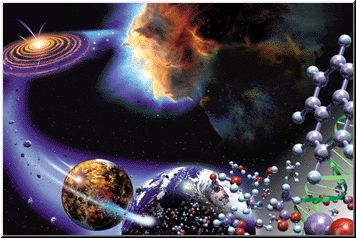|
In this section: Chance
or Design? • The Scientific Method •
Life in a Test Tube? • The
Eye • Irreducible Complexity •
Anything Can Happen? •
Evolution or Selection? • Real Examples of
Evolution • "Do You Feel Lucky?" •
(Abio)Genesis 1:1 • Life
from Comets? • Life on Mars? •
Richard Dawkins • A Brief
History of Slime...
"Life's A Gas!"
The
July
1999 issue of Scientific American featured the cover story
"Molecules from Space," which began with this statement:
Life's Far-Flung Raw Materials:
Life may owe its start to complex
organic molecules manufactured in the icy heart of an interstellar
cloud."
|
 |
The article featured the illustration below to depict how
this happened:

Image credit: Andy Cristie of slimfilms.com
It looks so easy when you explain it this way, doesn't
it! Apparently, we can't explain life originating on Earth all by
itself, so now we're turning to space to bring it to us.
Why do the theories change so often?
The article
explains how the "old" theories from just a few decades ago are
falling out of favor:
"New evidence has drawn the components of Miller's
atmosphere into question, but his primordial soup theory for how life's
ingredients were spawned in a warm pond or ocean on the planet's surface
still has a strong following. Some scientists have recently moved the soup
pot to the seafloor, where they say murky clouds of minerals spewing from
hot springs may have generated life's precursor molecules. But a growing
group of other researchers are looking at an altogether different source for
life-giving molecules: space."
What's wrong with Miller's theory? The article explains:
  "Amino acids exist in mirror-image pairs, a molecular quality called
chirality. Just as a person's hands look alike when pressed palm to palm but
different when placed palm to knuckles, individual amino acids are either
left-handed or right-handed. For little-known reasons and with rare
exceptions, amino acids in living organisms are left-handed. One criticism
of Miller-type experiments is that they produce equal numbers of both forms.
This is where extraterrestrial amino acids come out ahead. Since his first
report in 1993, John R. Cronin of Arizona State University has demonstrated
a slight surplus of left-handedness in several amino acids extracted from
two different meteorites." "Amino acids exist in mirror-image pairs, a molecular quality called
chirality. Just as a person's hands look alike when pressed palm to palm but
different when placed palm to knuckles, individual amino acids are either
left-handed or right-handed. For little-known reasons and with rare
exceptions, amino acids in living organisms are left-handed. One criticism
of Miller-type experiments is that they produce equal numbers of both forms.
This is where extraterrestrial amino acids come out ahead. Since his first
report in 1993, John R. Cronin of Arizona State University has demonstrated
a slight surplus of left-handedness in several amino acids extracted from
two different meteorites."
Is this theory any better?
How convincing do you find a "slight" surplus in "several" amino acids in
"two" meteorites as an explanation for the source of
life? Consider too its voyage on
that meteor:
-
It took tens of thousands, if not millions, of years to get here.
-
It traveled in the absolute zero temperature and
complete vacuum of
space.
-
It ignited in a fiery blaze upon hitting the Earth's
atmosphere, and
-
It burst in an explosion when it hit the Earth's
surface.
Is surviving all that to then seed life on Earth a reasonable
expectation? While the article calls the organic molecules on meteors
"complex," they're just polycyclic aromatic hydrocarbons.
Per NASA,
" PAHs
are a class of very stable organic molecules made up of only carbon and
hydrogen. These molecules are flat, with each carbon having three
neighboring atoms much like graphite. At right is a space filling
representation of the PAH coronene (C24H12). These
molecules are highly carcinogenic but they are also very common. They are
a standard product of combustion from automobiles and airplanes and some
are present in charcoal broiled hamburgers." PAHs
are a class of very stable organic molecules made up of only carbon and
hydrogen. These molecules are flat, with each carbon having three
neighboring atoms much like graphite. At right is a space filling
representation of the PAH coronene (C24H12). These
molecules are highly carcinogenic but they are also very common. They are
a standard product of combustion from automobiles and airplanes and some
are present in charcoal broiled hamburgers."
They've also been identified by the U.S.
Government as a hazardous contaminant, listed along with dioxin,
paraquat and cynanide. Most PAH's are less complex than the one shown, so
they're really simpler molecules than Miller's amino acids, which
in turn were nothing at all like the DNA found in life.
Question: Does this really seem more
"reasonable" than life forming here on its own or being created by
God?
Pop culture TV, books and movies also tell us that life was seeded on Earth by other
beings. The movie "Mission to Mars" used this as its
premise, only to have NASA show it to be wrong in
the same year. Is this really an answer at all or does it just avoid the question of
life's true origin by moving it somewhere well beyond our grasp?
Why don't we consider that God created life?
Is it because
the evidence makes it so unreasonable
or is it that
the implications make it so unthinkable?
In this section
Chance or Design? •
The Scientific Method •
Life in a Test Tube? • The Eye •
Irreducible Complexity •
Anything Can Happen? • Evolution or Selection?
• Real Examples of Evolution •
"Do You Feel Lucky?" • (Abio)Genesis
1:1 • Life from Comets? •
Life on Mars? • Richard
Dawkins • A Brief History of Slime...
|

